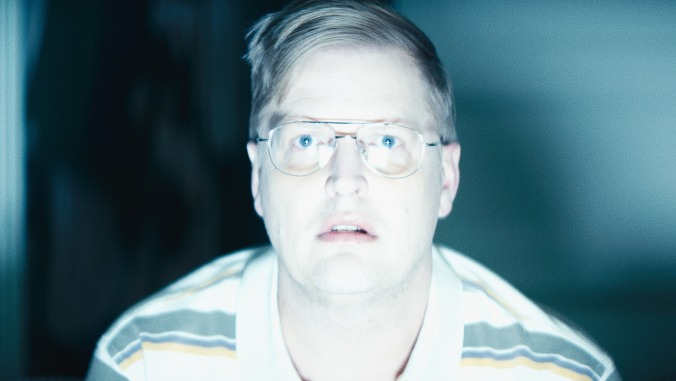The 1980s saw the release of several films that explored or otherwise hinted at a fear of the corrupting influence of modern culture and/or technology. Many were, at heart, possession stories:
followed put-upon teens seeking an outlet for their angst, only to stumble into something demonic. Though its primary interpretation is as a coming-out story,
also featured an awkward male lead mired in dark forces while navigating adolescence. And David Cronenberg’s
is one of the most enduring cinematic warnings against invasive technology, fusing body horror with a satire of consumerism.
Though set in 1990, Jon Stevenson’s feature directorial debut, Rent-A-Pal, feels very much like a holdover from the ’80s; with its acid-washed fashions and despair over the erosion of human connection, it recalls the cautionary tales of that era. But the film, which Stevenson also wrote, starts off firmly planted in the realm of drama: a stifling character study about a put-upon fortysomething, David (Brian Landis Folkins), who looks after his widowed mother.
David’s filial obligation to Lucille (Kathleen Brady), who has dementia, leaves little room for anything else in his life, but he mostly manages to hide his resentment. Still, there are flickers of annoyance in his expression when Lucille repeatedly calls him “Frank,” the name of her late husband, or when the video dating service he uses insists on payment even when he’s missed his chance at a match. Folkins, who previously worked with Stevenson on the horror film Hoax, brings considerable depth and anger to the role, never reducing David to a walking “lives in his mother’s basement” joke.
For much of its runtime, Rent-A-Pal is set to simmer, slowly turning up the heat with the arrival of Andy, the eponymous star of the VHS tape that David initially picks up as a consolation prize after his match, nurse Lisa (Amy Rutledge), moves on to the next date. Played with disconcerting cheeriness by Star Trek alum Wil Wheaton, Andy starts off spouting one-size-fits-all advice, but it sounds more tailor-made for his new “friend” David with each play of the tape. Folkins and Wheaton gamely hold up their ends of overlapping, unnervingly one-sided conversations. David gradually reveals more of his backstory, including the abuse he was subjected to as a child. Andy, meanwhile, comes across like a demented Mr. Rogers, encouraging audience participation and sipping whiskey while projected from inside a metal box.
David’s dependence on their canned interactions is unsettling; he drinks heavily while “playing” Go Fish with Andy, hanging on to each word of a raunchy anecdote as if hearing it for the first time. What once sounded “pretty fucking weird” becomes part of his routine—that is, until he’s given another chance with Lisa, who admires his devotion to his mother. Movies (particular of the horror variety) have set our expectations for what comes next when a lonely outcast, who’s struggled their whole life to connect with others, finds solace in a substitute—in this case, a video “friend”—but then tries to open themselves up to the possibility for real connection again. Folkins’ hulking presence grows increasingly ominous, and a confrontation seems inevitable.
For a while, Rent-A-Pal looks poised to subvert our expectations, showing a way forward for David without glossing over the tension or trauma. Stevenson capably blurs the line between a grounded, engrossing drama and something more preternatural. Early scenes of David are shot in a voyeuristic fashion, from angles both high and low, reminding viewers of their remove as well as their intrusion. This choice makes David’s discovery of the Rent-A-Pal tape feel both serendipitous and suspicious. But Rent-A-Pal goes full-tilt mayhem in its final act, shattering its carefully calibrated dread in a race to make an already belabored point: that technological advancements are to be questioned, and there is no substitute for human connection. This lesson extracted a high toll from David’s predecessors in ’80s cinema. Here, it once again costs an isolated character their humanity, and Rent-A-Pal its originality.


 Keep scrolling for more great stories from The A.V. Club.
Keep scrolling for more great stories from The A.V. Club.